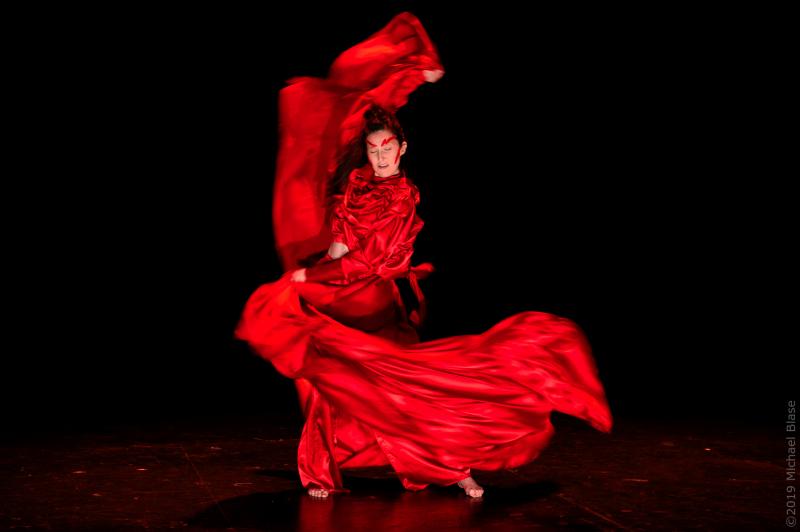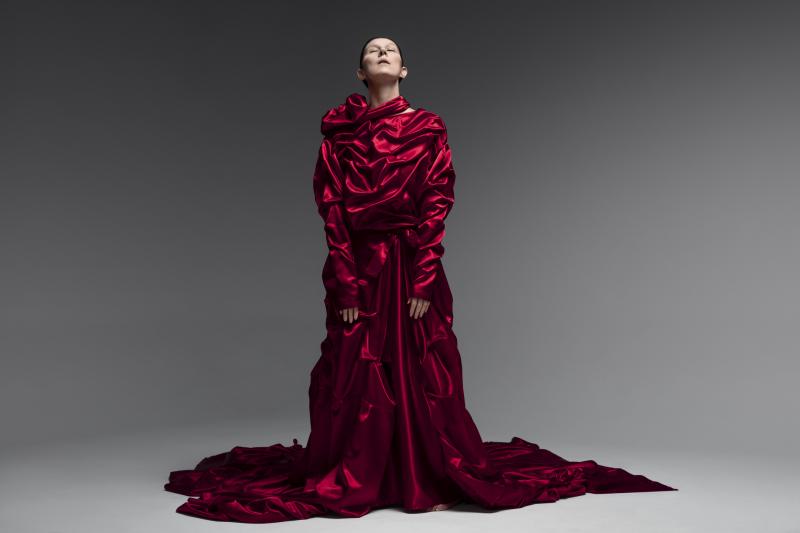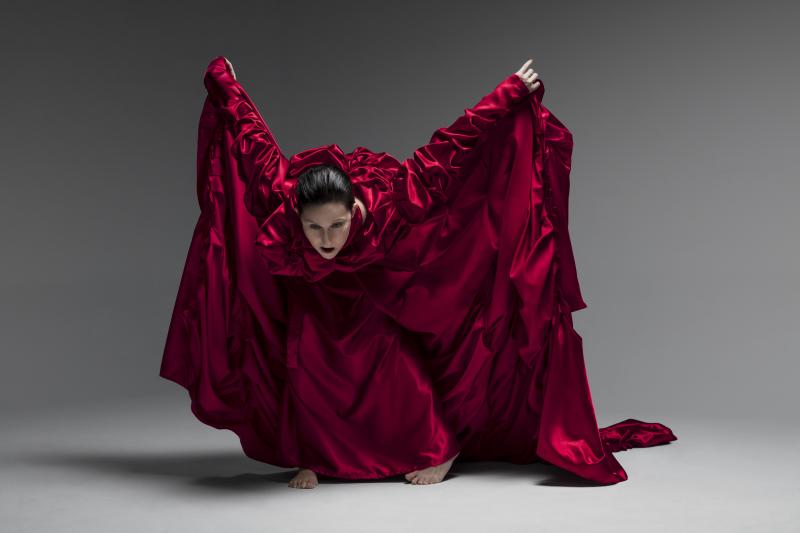Review: HIJIKATA MON AMOUR Honors A Trailblazer While Exploring the Future of Butoh

October is a special time in New York City. The month marks some of the last hot days where exposed flesh and outdoor seating is still possible, and also the first cool days, with temperatures plummeting then rising again drastically -- sometimes within the span of a week. The trees change their gowns to an emboldened hue before shedding them entirely, and the outward activity of summer transitions into a time for introspective reflections as one year comes to a close before another commences.
It all ends with Halloween (and, inevitably, Halloweekend, two of which bookended the cherished holiday of mystery, self-expression and revelry. October in the city is dramatic, contradictory and unpredictable, thus making it the ideal month to showcase a festival celebrating butoh -- the usual, often outrageous, relatively new yet ever-expanding and evolving physical theatre dance form that originated in post-WWII Japan but has since taken root in the hearts and art of practitioners and performers worldwide.
Some of them can be seen at the annual New York Butoh Institute Festival that is held for two weeks in October at Theater for the New City and featured the work of 14 national and international Butoh performers (from North America, South America, Europe and Asia), as well as workshops, masterclasses and lectures. At the helm of the festival is French-born butoh dancer, teacher, choreographer and curator, Vangeline, who is dedicated to bringing the myriad and individualistic expressions of butoh into the 21st century particularly through supporting and promoting female explorations of the art form.

recreated by Todd Thomas. Photo: Matthew Placek.
The theme for 2019 was "Bold. Butoh. Women." and concluded with a very special three night program created and performed by Vangeline herself called Hijikata Mon Amour, a personal homage to the founder of butoh, Tatsumi Hijikata. One of the most exquisite and appropriate aspects of this homage was the diaphanous, billowing crimson garment -- an exact replica of the late sensei's iconic attire worn in his legendary 1968 solo work, Revolt of the Body (Nikutai no Hanran), which was and remains a definitive moment in the history of butoh.
"For butoh's 60th Anniversary, it seemed fitting to honor the founder of the art form, but also, since our festival recognizes women's contributions in butoh, to symbolically focus on this costume, which was a women's garment," Vangeline explained. "Around 1966/68, Hijikata started growing his hair long, adopting the Japanese female linguistic style, and wearing women's costumes (backward). He also started working with female dancers around that time period. The influence of women on Hijikata was significant (he claimed that the spirit of his deceased sister danced inside him), and he also started a life-long collaboration with the female dancer Yoko Ashikawa around that time and other female dancers, such as Natsu Nakajima and Saga Kobayashi."
The costume, much like dance form itself, demonstrates aspects of the potent juxtaposition of opposites and contradictions coexisting simultaneously that defines the avant-garde dance theater. Both Butoh and the striking ensemble openly play with themes of gender fluidity and androgyny vs normalcy and conformity; Eastern vs Western styles and ideas; the grotesque and macabre vs the beautiful and transcendent; and the point where the past meets the future while existing in the present moment. Its intricacies have all been carefully considered, revived and immortalized again, like a spirit conjured forth by a medium to share its secrets through the channel of Vangeline.

recreated by Todd Thomas. Photo: Matthew Placek
The original totem-like garment was loaned to Vangeline by The Tatsumi Hijikata Archives -- who are committed to the preservation of Butoh and Hijikata's heritage. With a Janet Arnold Grant from the Society of Antiquaries of London to recreate the costume, cross-disciplinary art director, educator and designer, Todd Thomas (who utilizes aesthetics to act as an inspirational force for provoking meaningful socio-cultural implications) gave the forty-year-old piece a new life on Vangeline's stately form.
But this is where the similarities between Hijikata's Revolt of the Body and Vangeline's Hijikata Mon Amour cease. Butoh is not the kind of dance that is copied and repeated, the same choreography placed on different bodies over decades or even centuries like the work of Marius Petipa, Balanchine or even more modern-day masters such as Paul Taylor or Martha Graham. Butoh is as individual as each artist who enacts it. There are hallmarks, standards and elements that give it a certain recognizable style and, at its best, it is rooted in extraordinary physical, mental and emotional discipline, but each person's expression is as unique as they are and their work demonstrates their own internal and external journeys.
"On a personal level, to me, the piece represented the lineage: a student hears a teachers' voice and is forever changed by it," Vangeline described. "A butoh student must be lost to be found, walk in the dark, dive deeply inside themselves, and, as Tatsumi Hijikata said, 'pluck the darkness from their own flesh.' Butoh is a journey of self-discovery, of diving into our unconscious body memories," she extolled, "When we emerge, we still honor the teacher or lineage, but at some point, we must let the teacher go."
At the commencement of her performance, Vangeline stands on the stage as still as a mannequin showcasing the glorious scarlet garment. Her movements seem almost imperceptible but she is constantly in motion. Suddenly, as if from nowhere, her head is in profile. How did she get there? It almost gave the feeling of being in a (possibly haunted) museum or grand mansion where a particular statue seems to be watching you or moving; a seemingly inanimate object becoming animate. There is also a shift in the way you are forced to focus when action is born out of near stillness. It made me think of Andy Warhol's films such a Sleep, where the twitch of a nose became compelling or his Screen Tests, where every blink held potency and magic. Because of the slowness and deliberateness of her gesticulation, one becomes very aware of their own constant fidgeting and their body's restlessness in comparison to her controlled fluidity. Butoh is not an easy art form. It asks a lot of its audiences but much more of its dancers. Gradually she collapses on the ground, arriving there inch by inch with almost impossibly strained muscles and sinews guiding her down.
.jpg)
annual New York Butoh Institute Festival 2019
Photo: Michael Blase.
The next part was a distinctive opposite to the former. The movements are fast, sometimes erratic, fingers scuttling like a spider crawling out of her billowing robes, large gestures, bold movements and exaggerated facial expressions. The figure began as if puppeteered by some invisible force then was liberated to the point of puppeting its adornments, then proceeded to bouncing and shaking of the body free from any kind of resistance or restraints. It was playful, exuberant and even provoked sparse yet gleeful chuckles from the attendees. The calming sounds of the sea were replaced by "L'amour est un oiseau rebelle" from Bizet's Carmen, mingled with snippets of spoken word recordings in English and Japanese. The crescendos complimented the mood and gestures that towards the end became less controlled, more loose, frenetic and released. A sense of wild abandon and freedom marked the end of the performance.
The intensity of the opening (and the full work in totality) along with the attention span required of the audience was not lost on Vangeline. She noted: "The biggest challenge was the beginning of the piece, which is so very slow, to the point where the human eye cannot detect movement. These types of movements are challenging to achieve. I cannot honestly say that I feel 'triumph', but I really enjoyed venturing outside of what I am familiar with, such as making the costume into a puppet and giving Hijikata a voice at the end of the show. I enjoyed bringing humor into the piece, such as the section with the hands. The piece had to be choreographed around the costume, with its twenty yards of fabric. It took 100 hours of rehearsals to learn to seamlessly move in this costume; it took time to find ways to incorporate the costume into the story. However, I probably still need another 100 hours to perfect the piece. It feels as though the work is never finished."
.jpg)
annual New York Butoh Institute Festival 2019
Photo: Michael Blase.
Vangeline's choices might seem strange to some but they were all potently purposeful and personal too: "Symbolically, this is the story of butoh in reverse. When Hijikata performed Revolt of the Body in 1968, the film shows wild, erratic movements. In one of the sections of his piece, he wore a giant phallus and gyrated his pelvis in a disorderly manner. In contrast, by the time of his last solo performance in 1973, Hijikata's butoh had become very minimal and subtle."
"For the story of my piece, it made sense to reverse this and tell the story of a symbolic 'awakening', from no movement to more movement," she continued, "In reality, the movement is always there, underneath the surface: internal movement developing into or blossoming into externalized movements. Starting with these kinds of techniques is also effective because it forces the audience to concentrate their attention. I think their brainwave activity slows down with mine. It is also essential to consider how we can affect an audience and take them with us on this journey. By the time more movement occurs, I think the audience really enjoys the release of energy."
The inclusion of Carmen is a nod to both her own roots as a Frenchwoman and Hijikata's Western interests and inspirations. "Carmen symbolically represented this exchange between East and West in butoh. Hijikata also studied Flamenco dance, and he selected this red flamenco costume," Vangeline expounded.
Although Hijikata never left Japan (According to Ko Murobushi, he was afraid of flying), that did not prevent Western influences from reaching him. During his formative years as a dancer in 1956, Hijikata met the great teacher Hironobu Oikawa during the presentation of Carmen. Oikawa has just returned from having spent two years in Paris, where he studied ballet, and also Mime Corporel Dramatique with Etienne Decroux. Oikawa also studied with Jean Louis Barrault. Both Decroux and Barrault were followers of Antonin Artaud, who had founded the "Theater of Cruelty." After returning from France, Oikawa founded "La Maison d'Artaud in Tokyo and dedicated his life to sharing Artaud's techniques (Oikawa recently passed away on September 5, 2019, in Tokyo). This encounter was a pivotal experience for Hijikata which would inform the movements, philosophies and theatrics that would eventually morph into butoh. Hijikata's most prized possession was a recording from Artaud in 1947 (Pour en finir avec le Jugement de Dieu - To Finish With the Judgment of God). "Without Oikawa, butoh would probably not have developed into what it is today," Vangeline informed.
The effect of Artaud and his Theater of Cruelty -- which had a significant impact on the French surrealist movement and was groundbreaking in terms of the use of the voice and sound -- is clearly at work here.
So Vangeline's exaltation to the founder of butoh is, in ways, a celebration of her culture, his and a means to bring them together full circle.
.jpg)
annual New York Butoh Institute Festival 2019
Photo: Michael Blase.
Although Hijikata Mon Amour is a solo performance piece, Vangeline is hardly alone in her efforts. Her collaborators offered elements so utterly integral to the piece that they acted as characters within it. Much has been mentioned about the costume, but that is because the entire work was formed around it, making it more than bolts of fabric but her dance partner and propeller of the narrative. "At times, I felt that the costume choreographed with me. The garment became part of the dramaturgy - its use informed each vignette (The Girl With The Pearl Earring, Ghost Crossing, Mermaid, Shipwreck, Cocoon, Hands and Puppet)."
In addition to Todd Thomas' striking recreation, lighting designer Daniel Kersh ignited the mood of the dance by beginning with hauntingly subtle low lighting and the theater otherwise in total darkness with concentrated red and yellow beams that cast an eerie glow on Vangeline. Then, as the piece transitioned from near stillness to energetic movement, he contrasted with stark white hot washes that shifted the energy as if heavy velvet curtains were suddenly thrown open to reveal the sunlight in its full zenith. The spectre of sensei Tatsumi Hijikata also made multiple appearances, not only in the general tribute, historical contributions and costume inspiration, but in his very voice. A rare recording from 1976 of his How to Eat a Watermelon was integrated into the performance masterfully by musical arranger Diwas Gurung who took the audience on an aural journey that featured meditative, soothing soundscapes of ocean waves with a steady droning, French opera and Hijikata's nearly incoherent mutterings in Japanese.
Vangeline explained the significance of Hijikata's bizarre ramblings: "In that recording, Hijikata is lecturing his students on how to eat a watermelon. It is, of course, absurd. Students flocked in, hoping to receive a lecture from the master on how to dance butoh, and he instructed them on how to eat fruit. This reminds me of the last word of Socrates: just before he died, his followers leaned in, hoping to glean wisdom from the great philosopher, and instead, his last words were 'Crito, we owe a c*ckto Asclepius. Do pay for it. Don't forget.' His followers were startled and disappointed. In the same vein, butoh tends to disrupt our expectations. That is some kind of essential message in butoh; let go of your expectations and projections. These are words to live by."
When reflecting upon the release of the teacher in order to come into one's own, Vangeline mused, "At the same time, the teacher is never really gone: as we let them go, they live on in our memory, which, in dance, means that they live in our body memory forever. To me, that is the journey of transmission of knowledge in butoh. The dead are never really dead in dance; by teaching the next generation, teachers can live forever in the bodies of the living. It is some kind of beautiful haunting."

recreated by Todd Thomas. Photo: Matthew Placek.
There was one notable bit of dialogue in a recording that was in English that was featured in the latter half of the piece. It is a quirky moment but it left a strong impression. When I queried Vangeline she told me that it was a live recording of a rehearsal of Jesse Norman singing Carmen, accompanied by the Orchestre National de France conducted by Seiji Ozawa (this was the recording of Carmen that was used throughout). The dialogue is between Ozawa and Norman (who sadly passed away recently- she was still alive when the soundscape was selected) who is expressing her insecurities yet praising the work.
"I loved the fact that this was a rehearsal, and that this celebrated opera singer acknowledged how difficult the piece is to sing," Vangeline told me, "She also states: 'It's brilliant.' I loved that statement. It reminded me that art is difficult, that it takes so many repetitions, rehearsals, effort, but the results can be brilliant. As artists, we always strive to inhabit beautiful works of art and give them life and do them justice. We are never sure that we will measure up to that brilliance."
For anyone who has the pleasure of watching Vangeline perform, that pretty much sums it up -- it may be a difficult journey yet it is brilliant, and a challenging yet triumphant experience for both performer and viewer. Hijikata would have been proud.
For more information about Vangeline and the New York Butoh Institute, please visit: www.vangeline.com
Reader Reviews
Videos


